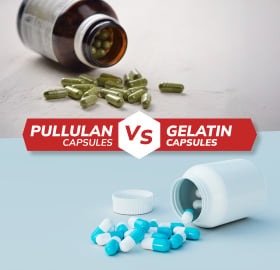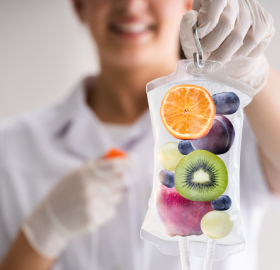In today’s increasingly visual world, the role that colors play in the success of pharmaceutical and nutraceutical products is likely becoming increasingly important. After all, capsule colors can play a vital role in:
- Product and dosage identification – Colors can provide differentiation both during manufacturing and at consumers’ homes or care sites. If banding is used, each capsule can have up to three colors, as the capsule’s cap, body and band can each be made in a distinct color.
- Patient compliance – Patients generally find it easier to remember to “take my yellow pill” than to remember to “take my [drug name] medication.”
- Product aesthetics – Colored capsules can mask unattractive fill materials, thereby increasing consumers’ confidence in the product’s quality and stability.
- Light protection – When a fill material is sensitive to light, a capsule colorant can be chosen based on its ability to provide light protection for a given wavelength or range of wavelengths.
- Branding and marketing – Colors are one of the many aspects of a capsule that can be customized to meet branding and marketing needs.
- Product perception – Studies have shown that color can influence a consumer’s perception of both what a product can do for him or her (for example, people associate bright red or yellow capsules with stimulation) and how well it will work.
Given all of this, it’s no wonder that so much thought and research goes into selecting the optimal colors for a product! Here’s some important information about capsule colors…
Capsule colorants must also be food colorants
Because capsules are meant to be ingested, capsule colorants must meet stringent safety requirements. In most countries, the dyes and pigments approved for use in capsules are those that are also permitted for use as food colorants.
Synthetic dyes are the most commonly used dyes
Hard capsules are essentially a film that has been formed into a capsule shape. The colorant is added to the film mixture when it is at the liquid stage. This means that the color is an integral part of the capsule itself, not just something that is added as a coating.
Because of this, it is not surprising that synthetic dyes are primarily used in their water-soluble form. From the chemical standpoint, most synthetic dyes come from one of the following chemical classes: Azo dyes, indigoid dyes, quinophthalone dyes, triarylmethane dyes or xanthene dyes. Synthetic pigments are often obtained from iron oxides, especially Black Iron Oxide, Red Iron Oxide and Yellow Iron Oxide.
One of the reasons that synthetic dyes are so popular is that they can be used to make gelatin or vegetarian capsules of nearly any color, with color that is completely consistent from one batch to the next.
CapsCanada’s G-CAPS® gelatin capsules and K-CAPS® HPMC vegetarian capsules are both available in a broad range of standard colors, with custom colors – including Pantone color matching – available. Brands can choose from more than 80,000 color combinations to make their capsules stand out.
Natural dyes are gaining in popularity
Thanks to the clean labels and sustainability movements, natural dyes and other natural colorants have been gaining in popularity, especially for nutraceutical products. In effect, natural dyes are used to make a product event more “natural.” For this reason, most capsule manufacturers that work with natural dyes only make their vegetarian capsules available with these colorants, as vegetarian capsules can be made to meet a larger number of other clean labels requirements as well.
As the name implies, natural colorants are derived from natural sources, primarily plants. Common sources for natural dyes and colorants include annatto, carmine, chlorophyll, saffron, spirulina and vegetable carbon (which is used to make unique black colored capsules).
In addition to being non-toxic, non-carcinogenic and eco-friendly, many natural colorants also have a high nutritional value. Since the process for extracting the colorant from its source is not selective, natural colorants contain some of the nutrients that are found in the source plant, flower or other natural item.
That said, there are two things to be aware of when switching from capsules made with synthetic dyes to those made with natural dyes. First, because these dyes are made from natural sources, you are likely to see some variations in color from one batch to the next. Second, some natural colorants will fade when exposed to UV or IR light for periods of time. This issue can be mitigated by your product packaging.
Capsules can be made with or without TiO2
For decades titanium dioxide (TiO2), an inorganic compound that combines the natural metal element titanium with oxygen, has been used in capsule manufacturing. Titanium dioxide is an excellent white coloring that can also be mixed with other dyes and colorants to create capsules that are completely opaque.
In addition to being an outstanding opacifier, TiO2 also withstands heat and light exposure, does not interact with other ingredients and can absorb UV light. Recent studies, however, have brought its safety into question. While the U.S.’s Food and Drug Administration (FDA) feels that these studies are inconclusive and that TiO2 is indeed safe for human consumption, the European Union disagrees. The EU has responded to these same studies by banning TiO2 as a food additive in food and food supplements as of August 7, 2022.
In response to the EU’s ban – as well as to meet clean labels demands – high-quality capsules are now available that do not contain TiO2.
For example, both G-CAPS® gelatin capsules and K-CAPS® vegetarian capsules are now available in versions free of TiO2.
Just like the other versions of these capsule products, the TiO2 free G-CAPS® and K-CAPS® are available in a wide variety of standard colors as well as in custom colors and Pantone matching colors. K-CAPS® made with natural colorants are free of both TiO2 and calcium carbonate.
Need help choosing the right color and type of colorant for your product?
CapsCanada’s R&D team is available to help you. Access expert assistance by contacting us at contact@capscanada.com
















